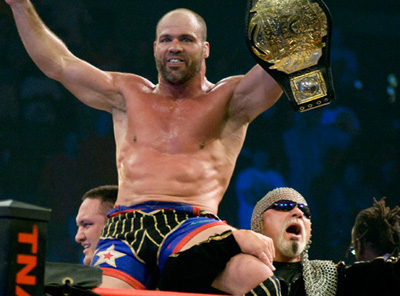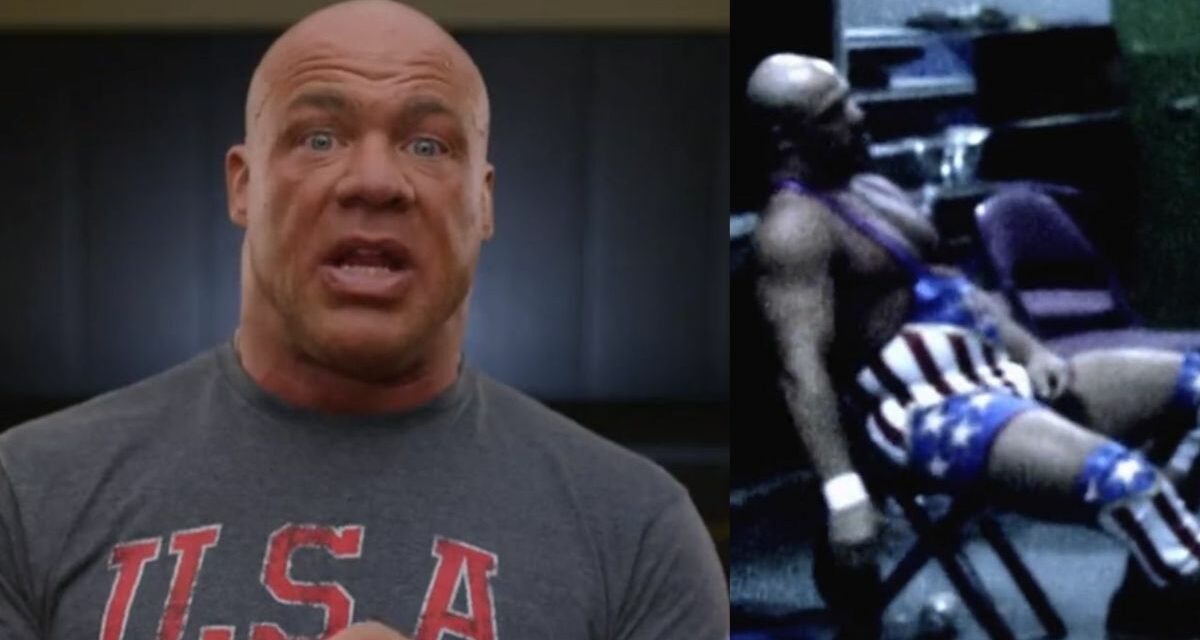There are some people whose lives are perfectly suited for the A&E Biography treatment. Kurt Angle fits the bill — it’s true, it’s damn true.
However, as compelling as it was — and it was very, very compelling and emotional — there’s little question that it was WWE-centric. Remember, Angle actually spent longer wrestling in TNA/Impact than he did in WWE. There was a brief clip of Angle against Samoa Joe, and Jim Ross saying, “The debacle of a run he had in TNA, he’s lucky he’s not dead. Seriously.”
Setting aside that serious slight, understandable since WWE is co-producing these Biography episodes with A&E, the rest was great. It started off with a bold statement from Kurt Angle: “I always thought my destiny was the Olympic gold medal. But being in WWE, this is what brought me real joy. This is my first love.”
They truly went over and above getting so many different voices into the piece. We heard from Angle’s three brothers, his second wife (notably not his first), and oodles of people from the amateur wrestling world — far more than I expected, which was great. There were a couple of friends outside of wrestling too, which was good as well.
It starts off talking about growing up in Pittsburgh, how tough his brothers were, and how Kurt was a good boy compared to the other three. Kurt also mentions his sister Le’Anne, as “only one my Dad ever hugged.” Their father had been in the military, so it was a disciplined household. Their father was working in construction, fell, and was on life support. Kurt talking about that experience, seeing his mother fall apart, begging her husband to come back before pulling the plug, was only the first of many emotional roller coasters.
Kurt played football the week his Dad died, and had an amazing game. “Football was my first love,” he said.
But in high school, he also started amateur wrestling, and in 1987 was state champion and then took the Junior Nationals too.
Bob Bubb, who was Angle’s coach at Clarion University, is brought in, and then a dizzying number of key players in amateur wrestling, from coaches to trainers to champions: Sylvester Terkay, Greg Strobel from Team Foxcatcher, Bruce Baumgartner, Bruce Baumgartner, Kevin Jackson, Bruce Burnett (and Ronda Rousey from the world of judo). The vintage footage of Angle’s amateur days wasn’t always the best quality but it was fascinating to see how some of the mannerisms that we knew from his pro days had been there from time on the amateur mat, like blowing kisses to the crowd. His backflip after the 1995 world championship in freestyle was a surprise.
Successful in college, Angle just builds and builds — there’s an amazing shot of his training calendar, and the intense workouts he subjected himself to — and overworking is a phrase he uses.
Angle was invited to Team Foxcatcher, a training facility run by John du Pont in Newtown Square, Pennsylvania. Surrounded by so many other top-tier competitors, and with the bills paid by the philanthropic du Pont, Angle develops into an incredible stud of a wrestler. A key trainer was wrestler Dave Schultz. “When I looked at him, he was everything I wanted to be,” Angle said of Schultz. du Pont, however, was unstable — “he wasn’t right,” said Angle — and, in early 1996, shot and killed Schultz.
Nancy Schultz, Dave’s widow, detailed those dark times. Kurt was Pittsburgh and had left Schultz a message the day of the murder. “It just crushed me,” he said, and then a vintage clip of Kurt talking about Schultz ran.
Kurt went off the Team Foxcatcher money, and ended up with Nancy Schultz’s new wrestling club in Dave Schultz’s honor.
Early in the Olympic trials, we see vintage footage of Kurt breaking his neck but not knowing immediately; a chiropractor told him about it being broken. Instead of stopping, Novocain was the solution. “I just never considered quitting,” said Angle.
Then come the 1996 Olympic Games in Atlanta, where Angle revealed, “I was still having some pain.” He quickly recaps his run to the gold medal bout against Abbas Jadidi of Iran, which Angle won, though the outcome was very much in doubt. “This is the best thing that’s ever happened to me .,.. If I died tonight, I’d be the happiest man in the world,” Angle said in an old clip, and is shown putting his medal around his Mom’s neck. We get clips of him on The Tonight Show with Jay Leno as a gold medalist and at the White House.
“What am I going to do now?” was the next question.
Jim Ross said Angle “was on the radar early and often.” In 1996, Angle traveled to the WWE head office, sat with Vince McMahon and was offered a 10-year deal. “I’ll sign it if I never have to lose a match,” Angle said he told McMahon. It was proof that Angle didn’t — yet — understand pro wrestling. (Left out of the narrative is an infamous moment that same year where Angle went to an ECW show and was appalled at what he saw; that’s okay, since it would have required yet again explaining what ECW was at the time.)
At home, Angle started watching wrestling, was intrigued by Stone Cold Steve Austin, which got him thinking about doing it again. Late in 1998, he called McMahon back and was put in touch with Jim Ross and they wanted him to try out. There was some really cool footage of Angle training (and it’s fun seeing who else was there), though he said he had trouble initially, since his instinct was not to be allowed to be thrown around. “I’ve seen so many amateur wrestlers come along, legitimately tough guys, who could never get it,” said Ric Flair at that point, one of many pro legends who are interviewed only briefly. Another was Dory Funk Jr., who helped train Angle, who only gets a brief clip. Yet Maria Menounos gets a couple of clips, go figure.
“I got a contract. It wasn’t handed to me. I earned it,” said Angle.
From there, it’s all about his remarkable ascent in WWE, starting in late 1999. “It came to me very quickly,” said Angle. “He didn’t think people would boo him and boy was he wrong. Oddly, though, we never got a clip of the fans chanting “You suck!” along with his instrumental entrance music. It was also a reminder how the crowd used to be so into the wrestlers during The Attitude Era, not force-fed to react. “I got on people’s nerves. It was a lot of fun,” said Angle.
Ross summed it up: “He had a natural propensity to be a pro wrestler. It just came to him. It was like a savant. A genius at this stuff.”
There’s some love for Vince McMahon, though he’s never interviewed directly for this Biography, but there is a recent shot of Angle visiting Vince at the office (er, former office). “I loved him like a father,” said Angle.
Angle was able to work with anybody on the roster, and have great chemistry. It was a blur of action and Angle Slams, drinking and spraying milk.
Dwayne “The Rock” Johnson was certainly one of Angle’s greatest foes, and was the one to introduce the dark underbelly of pro wrestling, the need for painkiller drugs.
Angle shies away from none of it, and the litany of broken necks from 2003-06 is, quite simply, insane. Yet he was always out there performing. That was also when he started taking opioids. JR said he called Angle and told him to get off the drugs: “It’s a sickness. They’re overmedicating. Then they start feeling really guilty, they feel very vulnerable, then stuff starts unraveling. It’s not just wrestling.”
A mostly unknown story of his sister Le’Anne’s drug problems was an aside, but a very revealing one. The family knew about her drug problems, prompted in part by three bad marriages. She would call Kurt for money, and eventually he cut her out of his life, and she overdosed on heroin. “I wish I would have talked to her,” said Angle, with a shot of him at her gravesite.
It’s not lost on Angle or the viewer that he had become an addict himself. “The higher I got, the better I felt. Or, I should say, the less I felt. Those painkillers can hide a lot of pain,” he said, figuring eventually he got up to 65 a day. “I was taking pills to feel normal,” he said. “I had to have my fix every day.” He even detailed where he was getting the painkillers, keeping up on his schedule.
Angle was told to go to rehab or WWE wouldn’t continue to employing him. Angle said he quit, but in an October 2006 clip of McMahon on Byte This, he said Kurt was fired.

Kurt Angle as TNA World champion, a reminder since it didn’t make it into the Biography.
Now we go to TNA — “I didn’t want to quit” wrestling — was all Angle said about that time. And that he added drinking to the painkillers during that TNA run. If TNA really was a “debacle” as Ross said, then shouldn’t A&E have gotten to talk to someone who hired him or worked with him there? A Jeff Jarrett?
Oh wait, they didn’t go into the whole Karen Angle/Karen Jarrett stuff either, and are just told that his first wife left with their two older kids.
Enter Giovanna, who he married in 2012, and has three kids with. Her discussing his downfall is impactful, and she’s brutally honest about it all, the toll it took on her and the family. Angle talks about driving while high and drunk, his DUIs, passing out by 5 p.m. with all the chemicals in his body. “The drugs took over my life. It was the worst feeling in the world,” he said.
A call to Giovanna from jail is the turning point and he headed to rehab. Angle on withdrawal:
It’s like getting tortured, the insides of your body pounding, your skin’s crawling, you’re sweating, because you’re hot, but you’re also sweating because you’re cold. You can’t think straight. Your body’s shaking the whole time. You feel like you don’t have any insides. You’re out of breath all the time. Your head’s pounding, your body’s pounding. You’re going to the bathroom, you’re throwing up. It doesn’t stop. It is absolutely the worst feeling I’ve ever had. It seems like it lasts forever. It was like death. I actually wished a few times I would die, that’s how bad it is. I don’t ever want to have that experience again.
From there, it’s a bumpy but redemptive ride, as we learn how he copes with chronic pain, including a lot of maintenance training, stretching, yoga.
Naturally, it ends with the WWE Hall of Fame in 2017 (with no mention of his International Sports Hall of Fame induction, his induction into the George Tragos/Lou Thesz Hall of Fame nor the TNA/Impact Hall of Fame).
“I think I want Kurt Angle to be remembered not for the mistakes he made, but what he was able to accomplish in his lifetime,” he concluded.
This was truly a terrific watch, even if there were huge chunks of his wrestling left on the wayside. Go out of your way to watch it.
RELATED LINKS
- Kurt Angle story archive
- Slam Wrestling’s A&E/Biography archive

